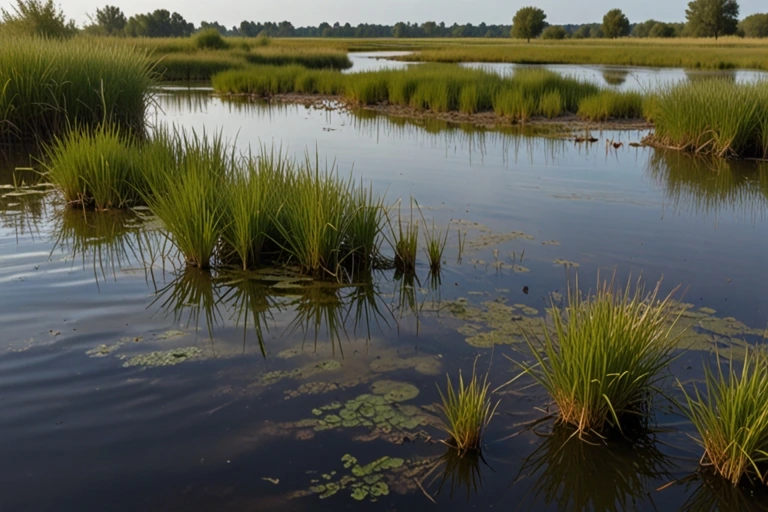Can we make ratification wetlands to stop flooding. It is one of the most destructive natural disasters, causing extensive damage to property, infrastructure, and ecosystems while threatening human lives. Rising climate change impacts alongside urban development deforestation patterns cause flood frequencies to increase with their destructive power. Research efforts have grown in response to this interest by developing artificial wetlands as sustainable flood-preventive solutions. But Can we make ratification wetlands to stop flooding. This text examines artificial wetlands’ functioning, advantages, and potential to become helpful flood management technology.
What Are Artificial Wetlands?
Can we make ratification wetlands to stop flooding? Are counterfeit biological systems intended to impersonate the elements of typical wetlands? Engineered landscapes of plants, soil, and water systems function as artificial wetlands to duplicate natural wetland operations. These constructed environments serve multiple purposes, including supplying purified water, enabling habitat development for nature, and controlling flood activities.
Natural wetlands function like water-consuming substrates by stealing surplus precipitation before gradually returning it to create controlled water streams and suppress torrential floods. Artificial wetlands duplicate original wetland capabilities while reducing flood risks and generating supplementary environmental outcomes. The question of whether we can make artificial wetlands to stop flooding hinges on the effectiveness of these engineered systems in mimicking natural wetland behaviors.
The mechanisms through which artificial wetlands help prevent flooding become the focus of this evaluation.
Can we make ratification wetlands to stop flooding by temporarily storing excess water and gradually releasing it to reduce peak flow rates during heavy rainfall? Here is a simplified explanation of their flood-prevention mechanisms:
Water Absorption: Both water and soil within artificial wetlands create substantial absorption that decreases the quantities of water, which finally flows to rivers and streams.
Slowing Water Flow: The natural flow of water through wetlands becomes slower because this process prevents sudden flood surges by avoiding the kind of flash flooding that leads to damaging floods.
Water Storage: The design of artificial wetlands often includes basin areas that function as stormwater collection reservoirs.
Groundwater Recharge: Water entering wetland soils generates recharge pressure to underground aquifers, lowering accumulated surface water levels. The success of establishing artificial wetlands to eliminate flood risks depends on the size, location and design elements used for each facility.to stop flooding is one of the most destructive natural disasters, causing extensive damage to property, infrastructure, and ecosystems while threatening human lives. In the face of increasing climate change impacts, urbanization, and deforestation, the frequency and severity of floods are rising. This has sparked interest in sustainable and innovative solutions, including creating artificial wetlands.
But Can we make ratification wetlands to stop flooding? In this article, we will explore how artificial wetlands work, their benefits, and whether they can serve as a viable tool for flood management.
How Do Artificial Wetlands Prevent Flooding?
Can we make ratification wetlands to stop flooding by temporarily storing excess water and gradually releasing it to reduce peak flow rates during heavy rainfall? Here is a simplified explanation of their flood-prevention mechanisms:
Water Absorption: Plants and soil in artificial wetlands absorb significant amounts of water, reducing the runoff volume that reaches rivers and streams.
Slowing Water Flow: Wetlands slow the water flow, preventing rapid surges that can lead to flash flooding.
Water Storage: Artificial wetlands can be designed with basins to store large volumes of water, acting as reservoirs during storms.
Groundwater Recharge: Water infiltrates the wetland soil and replenishes underground aquifers, reducing surface water accumulation.
The ability to make artificial wetlands to stop flooding depends on their size, location, and design. Wetlands extending across larger areas with multiple vegetation varieties and well-structured drainage features become stronger at controlling floodwater.
Benefits of Artificial Wetlands Beyond Flood Control
While the primary focus is often on flood mitigation, can we make ratification wetlands to stop flooding offer a wide range of environmental and social benefits:
Water Quality Improvement: Artificial wetlands utilize their filtering system to pull pollutants, sediments, and nutrients from stormwater, thus enhancing water quality in nearby rivers and lakes.
Habitat Creation: The same area acts as an essential home that supports fish, birds, and multiple forms of wildlife, thereby establishing healthy ecosystems.
Carbon Sequestration: Wetland vegetation is a vital carbon dioxide capture and storage system supporting climate change efforts to lower atmospheric carbon dioxide levels.
Recreational Opportunities: Artificial wetlands operate as green spaces in cities by creating recreational areas while providing learning opportunities.
Cost-Effective Infrastructure: Installing artificial wetlands is a better flood control option than traditional infrastructure such as dams or levees, and it benefits the community financially and enduringly.
Additional Benefits of Artificial Wetlands
Urban Heat Island Reduction: Can artificial wetlands be created to prevent flooding and lower temperatures in urban areas by providing green spaces and water features that calm the surrounding environment?
Cultural and Aesthetic Value: Wetlands serve as visual attractors for landscapes while becoming landmarks that boost community identity and regional importance.
Educational Opportunities: Ecological systems operate as interactive evaluation settings that enable academic institutions to conduct research about ecology, hydrologic investigations, and sustainable programs.
Disaster Resilience: Establishing artificial wetlands helps communities become more resilient by minimizing flood risks and speeding up residents’ recovery after extreme weather events.
Challenges in Creating Artificial Wetlands for Flood Management
While can we make certification of wetlands to stop flooding holds promise, several challenges must be addressed to ensure their success in preventing flooding:
Land Availability: Extensive artificial wetland projects require vast land to develop, but cities with dense populations frequently face land shortages.
Initial Costs: Although the initial financial expenses for artificial wetland design and construction are expensive, operating costs are typically lower than those of traditional construction methods.
Design Complexity: Successful implementation of effective wetland ecosystems requires specialized knowledge and strategic planning techniques to maintain appropriate hydrologic functions, select suitable vegetation, and draw designs for soil composition.
Maintenance Needs: The operation of artificial wetland facilities depends on frequent maintenance and management to prevent water blockages, the growth of invasive species, and system equipment malfunctions.
Limited Capacity: Artificial wetlands’ storage capacity remains limited, requiring additional flood control measures to perform efficiently during severe weather scenarios.
Case Studies: Successful Implementation of Artificial Wetlands
To better understand the potential of making ratification wetlands to stop flooding to stop flooding, let’s look at some successful examples from around the world:
Singapore’s Bishan-Ang Mo Kio Park: Designers integrated artificial wetlands to create naturalized river systems that operate and transform concrete canal structures into park areas. Artificial wetlands effectively control stormwater, reducing floods while offering recreational areas that benefit residents.
Hammarby Sjöstad in Sweden: The district demonstrates ecological sustainability through artificial wetlands that manage stormwater processes. The system prevents flooding while improving this territory’s biodiversity and water quality.
Everglades Restoration in the United States: This massive restoration effort incorporates engineered wetlands systems that regulate water flows and act as flood mitigation structures, among other objectives, to reestablish natural wetlands.
These examples demonstrate that ratifying wetlands to stop flooding can be effective when integrated into broader flood management strategies.
Maximizing flood control measures requires the proper design of artificial wetlands.
When deploying artificial wetlands for flood mitigation purposes, the design procedures require specific attention to achieve success rates. Key considerations include:
Location: Artificial wetlands should be placed in high-flood areas near urban areas to catch excessive rainfall that may disrupt urban environments.
Size and Scale: The specific size of the artificial wetland depends on the quantity of rainwater expected during extreme weather conditions.
Vegetation: A proper selection of native plant types serves vital functions that include water purification along with storage and habitat development.
Hydrology: The hydrological system requires specific design features that support dynamic fluctuations for adequate drai, which is necessary and suitable for water management.
Integration: Can we ratify that wetlands to stop flooding should be part of a comprehensive flood management plan that includes green infrastructure, stormwater detention basins, and traditional measures like levees and reservoirs?
Do Artificial Wetlands Provide a Complete Solution for Preventing Floods?
While we Can we make ratification wetlands to stop flooding, which can significantly reduce flooding risk, it is not a standalone solution. Various environmental elements determine flood occurrence by combining water precipitation intensity with land use patterns and watershed measures. To achieve effective flood control, artificial wetlands should be integrated with other strategies, such as:
Urban Planning: Partnerships with urban designers to implement green roofs, rain gardens, and permeable surfaces should reduce surface runoff.
River Restoration: By restoring natural floodplains and eliminating barriers, builders can enhance water flow through the landscape.
Climate Adaptation: Establishing policies to rectify climate change origins and weather system weakness mitigation policies.
Artificial wetlands are potent tools that can promote advanced technology with policy enforcement and active community engagement to develop their full potential.
Conclusion
So, Can we make ratification wetlands to stop flooding? Artificial wetlands prove effective at stopping flooding under particular conditions. Artificial wetlands represent an innovative climate-adjacent solution that decreases flood hazards while delivering multiple ecological advantages and enhancing water quality. These structures find optimum results when operating inside a comprehensive flood management system that connects various elements.
By investing in, can we make ratification wetlands to stop flooding, we can create resilient communities better equipped to handle the challenges of climate change and urbanization. With careful planning, collaboration, and commitment, Can we make ratification wetlands to stop flooding? Do they have the potential to transform the way we manage water and protect our cities from flooding? The promise of this revolutionary technology enables us to establish a safer, sustainable future.


